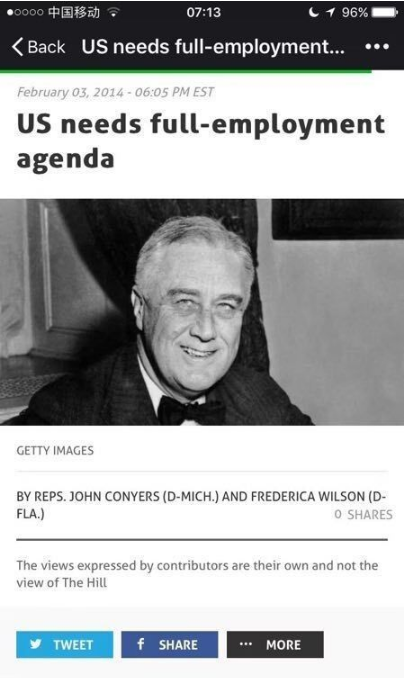2017年10月07日新SAT北美地区写作原文
2017年10月07日北美SAT写作原文如下:

经过和多位这次在北美考试的烤鸭进行确认,本次10月7日考试的试题文如下(已对原文删改)
原文第二个方框处的论点现在未得到确认(不过按道理CB会释放这份试卷,所以坚哥发出来就是给12月考试的烤鸭们练练手来的)
1 In the wake of an unprecedented period of high unemployment and amid turmoil overseas, a president stood before a joint session of Congress for his annual State of the Union address, offering a bold vision to expand economic opportunity, strengthen the middle class and reduce inequality.
2 The year was 1944. The president was Franklin Delano Roosevelt.
3 The “Second Bill of Rights,” unveiled during the State of the Union 70 years ago, was not a constitutional amendment but a statement of principles for America’s economic future. It was centered on a commitment to achieving a crucial national objective: full employment.
4 With 50 million people, including 13 million children, now living below the poverty line and both parties seeking to address the national opportunity deficit in 2014, America’s political leaders should take a cue from FDR’s 1944 State of the Union. Congress should commit to do everything in its power to create the economic conditions for America to return to full employment. Getting every American working and contributing to the tax base will not only help eliminate poverty but also reduce the national debt and ultimately create the conditions for the free market to function well.
5 In the decades following FDR’s speech, Congress took serious action to realize the vision of a full-employment society. It passed the Employment Act in 1946, giving the federal government tools and a formal calling to “promote maximum employment, production, and purchasing power.” It passed a range of legislation to promote full employment through additional investments in transportation, health, education and research in the 1960s. Finally, in 1978, it passed the Humphrey-Hawkins Full Employment Act, calling on the president to work with the private sector to reduce unemployment to specific target levels.
6 Contrast these efforts with the inaction in today’s Congress. With nearly 30 million American workers either unemployed or underemployed, each and every lawmaker should enshrine job creation as Priority No. 1. Yet Congress has actually made unemployment worse. The economic consulting firm Macroeconomic Advisers estimated that the fiscal showdowns and budget cuts that have consumed Congress over recent years have cost the country up to $700 billion in economic growth and more than 2 million jobs.
7 As collapsed bridges, contaminated water and falling positions in global education rankings demonstrate, there are plenty of public projects our country needs to undertake. This is why we’ve been advocating for legislation — including the 21st Century Full Employment and Training Act and the American Jobs Act of 2013 — to create new opportunities to solve public problems while hiring educators, infrastructure-builders, first responders and medical researchers. There are good ideas in both parties for closing the skills gap, spurring infrastructure investment and reducing unemployment. But we need political will to pass a serious jobs bill.
8 This week, we’re announcing the creation of the Full Employment Caucus in Congress. As co-founders, we will regularly host expert economists and policymakers to discuss proven job-creation proposals and implement strategies for their adoption.
9 Achieving full employment isn’t only about helping jobless people. When we return to full employment, investors and businesspeople have more customers. When we return to full employment, workers have power to bargain for higher wages. Finally, when we return to full employment, crime declines as desperate people gain a paycheck and a purpose.
10 We’re founding this caucus to strength America’s economy and restore dignity for the tens of millions of Americans who have suffered the physical and emotional pain of joblessness.
11 Both President Obama’s State of the Union address and the Republican response echoed FDR’s emphasis 70 years ago on expanding economic opportunity, creating jobs and boosting wages. It’s time for Congress to pass a comprehensive jobs bill to realize that vision.
1007北美考回
此次北美地区的考试有两点值得我们关注:
1、美东的考试中阅读出现了加试,(四部分结束后,阅读加试20分钟,16个题目)这是改革后的SAT出现这种情况。
2、另外,跟我们之前预测的一样,数学加试在8月26号北美考试出现以后慢慢成为常态化。我们在纽约考试的考生反馈,数学加试(可用计算器)20分钟。可以预见在不远的将来,加试会是SAT常态化的事情。
北美区SAT考情分析
1阅读部分Passage 1
小说类:关于作者和叔叔去自家商店(墨水和钢笔)看经营状况,听老板讲墨水和钢笔的学问,延伸到人生意义。这篇文章跟亚太考区的小说选材有异曲同工之妙,亚太小说节选自:Barbara的Flight Behaviors。故事里面母子两位主要人物去郊区看蝴蝶。但是儿子眼睛看不见,文章主要讲解母亲的一些内心思考。看来CB这次小说的选题,偏向性非常明显,在亚太和北美倾向性一致
Passage 2
社科类:北美阅读的第二篇依旧是社科类。主要讲述了学者提出目前网络的广泛使用会改变人类的记忆模式(通过四组社会实验佐证),这跟亚太考区社科类文章关于凯恩斯经济学和布雷顿森林体系相比较,个人认为要简单一些。
Passage 3
科学类:讲了一种鱼(guppy)在实验室环境和自然环境下,繁殖能力和后代生长状态会受捕食者数量的影响(捕食者越多,后代会越多,但重量会小)。这跟亚太考区的第三篇科学关于(Gold in trees may hint at buried treasure)同属于实验结论类文章,文章结构简单和观点清晰,算是较为简单的文章题材。
Passage 4
历史类:北美第四篇的历史和亚太考区依旧一致:关于女权和奴隶制,不同的是亚太考区是以双篇的形式出现,北美是单独文章,女权和奴隶制是历史类文章比较钟爱的题材。
Passage 5
科学类(双篇):北美第五篇是科学(双篇),主要讲述了抗体和抗原
篇讲的是新抗体的研制比较困难,而抗原容易有抗药性;第二篇讲一种抗体研制的原理。
本篇科学类文章难度总体适中, 跟亚太考区的关于海底生物的选材也差不多。
注:此次考试阅读部分进行了加试,考察了双篇科学,主要探讨关于原始火星,其实是wet not warm 的假设。
2文法部分Passage 1
国家为了缓解交通保护环境,促进大家使用公共交通,准备推行BUS免费政策,文章主要从经济、社会角度讨论这项政策的利弊。
Passage 2
随着数码相机的普及,早先的拍照技术慢慢消失。文章主要介绍了目前某些摄影家依然会用wet plate photography,讨论了这项技术的原理和利弊。
Passage 3
主要讲解城市建筑师的underground work
Passage 4
暂缺
3数学部分数学部分难度适中,与往常题目难度持平,没有所谓的简单很多。所有知识点和平时训练的完全一致,但之后的复习需要多关注以下涉及知识点。
涉及到的知识点:
1、三个函数的交点问题(图像题)
2、不等式组的解和可行域(图像问题;实际问题)
3、复杂图像的平移问题
4、参照方程式的恒成立和恒不成立问题(考察了四道题)
真题下载:









